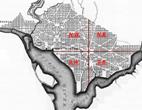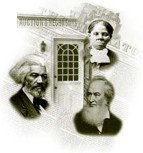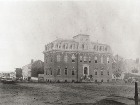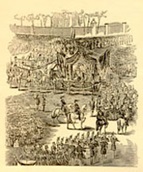19th Century Neighborhoods |
 |
When James Croggon died in 1916 he was described as probably the oldest newspaper man in Washington. He began his career in 1862, writing many stories of the Civil War. He retired in 1894, and from 1906 to 1915 The Evening Star published approximately 300 of his articles. His interest was the early history of the Capital city, and he wrote of holiday traditions, merchants, organizations such as the fire department and much more. The majority of the articles focus on city neighborhoods, describing the buildings and property owners. |
Underground Railroad Operatives |
 |
The Underground Railroad was a network of free African Americans, slaves and white men and women who dedicated themselves to assisting slaves to escape to freedom. This collection documents the lives and activities of five Washington, DC residents who participated directly or indirectly in the Underground Railroad -- William Boyd, a conductor on the UGRR; John Dean, an attorney who risked his life defending fugitive slaves against Maryland slave owners; David A. Hall, an attorney who was the first to come to the aid of the crew and fugitive slaves on board the Pearl; Hannibal Hamlin, cousin of Abraham Lincoln's first Vice President, a founder and first president of the National Freedman's Relief Asssociation of DC; and Ann Sprigg who operated a boarding house across the street from the U.S. Capitol that was known as Abolitionist House. |
D.C. Public Schools |
 |
In 2004 the Sumner School Museum hosted an, "For Whom The School Bell Tolls," featuring persons for whom the D.C. Public Schools are named. This collection features some of the photographs and captions that appeared in the exhibition. In most cases the collection consists of a photo of the school, the person for whom it is named, and a tombstone, if one could be found. In many cases the schools in this collection have been razed or converted to other uses. |
Washington Funerals of Note |
 |
Throughout much of the 19th century it was the custom to provide elaborate funeral services and processions for all politicians, military officers and prominent citizens who died in Washington. This collection documents the funerals of three presidents, congressmen, Mexican war heros, Civil War generals and prominent citizens. All vie for the honor of being the most "splendid" including that of Lieut. J.P. Borden (1842) who died in a naval accident. His funeral procession consisted of 11 barges carrying his remains, the U.S. Marine Corp band, and numerous officers and members of the U.S. Marine Corps and U.S. Navy. President Taylor's funeral procession was so long that the first units reached Congessional Cemetery 2 miles away before the last units left the White House grounds. |
The Wawaset Steamboat Disaster |
 |
On August 8, 1873, The Wawaset steamboat left the 7th Street Pier in Southwest Washington on a regular run down the Potomac. It had stopped several times on the way and there were approximately 120 adults and 20 children on board by the time it reached Chatterton's Landing in King George County. As it was approaching the landing at about 11:40 a.m., a fire broke out in the engine room. Within minutes it had consumed the entire boat. Family and friends waiting on the landing watched in horror as 75 passengers and 2 of the crew perished either by fire or by drowning. |




